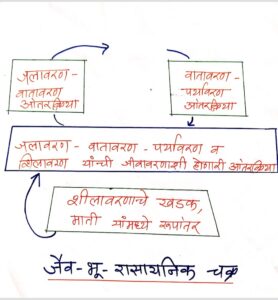9th, Energy Flow in an Ecosystem, carbonn cycle Oxygen cycle, 3, 9 वी, परिसंस्थेतील ऊर्जा प्रवाह, कार्बन चक्र, ऑक्सिजन चक्र 3.
आपल्या मुख्यतः विज्ञान विषयक What’s App समूहात सामील होण्यासाठी🙏 पुढील लिंकला स्पर्श करा🎷
जैव-भू-रसायन चक्र:–
व्याख्या:- पोषद्रव्यांच्या परिसंस्थेतील चक्रीय स्वरूपातील प्रवाहाला जैव-भू-रसायन चक्र असे म्हणतात.
शिलावरण, जलावरण व वातावरण यांनी मिळून तयार झालेले जीवावरण यांच्या माध्यमातून जैव-भू-रसायन चक्र अविरत चालू असते.
सजीवांच्या वाढीस आवश्यक असणाऱ्या अजैविक घटकांकडून जैविक घटकांकडे आणि जैविक घटकांकडून अजैविक घटकांकडे रूपांतर होत असते.
जैव-भू-रसायन चक्राचे दोन प्रकार आहेत.
वायु चक्र:-
उपयुक्त अशी पोषद्रव्ये उदाहरणार्थ नायट्रोजन, ऑक्सिजन, कार्बन (कार्बन डाय-ऑक्साइड) यांचा संचय पृथ्वीच्या वातावरणात आढळते.
अवसादन चक्र (भू चक्र):- उपयुक्त अशी पोषद्रव्य उदाहरणार्थ लोह, कॅल्शियम, फॉस्फरस, यांचा संचय पृथ्वीवरील मृदा, अवसाद (गाळ) व अवसादी खडकात (गाळाचे खडक) आढळतो.
वायुचक्र व अवसादन चक्र ही दोन्ही चक्रे एकमेकांवर अवलंबून असतात.
अवसादन चक्रापेक्षा वायु चक्र हे वेगाने घडते. उदाहरणार्थ एखाद्या ठिकाणी आग लागली असेल तर त्या ठिकाणी ऑक्सिजनचे प्रमाण कमी होते व कार्बन डायऑक्साइड चे वाढते. पण थोड्याच वेळात वाऱ्यामुळे त्याची लगेच विसरण (पसरणे) होते.
कार्बन चक्र, ऑक्सिजन चक्र आणि नायट्रोजन चक्र ही तिन्ही महत्त्वाची जैव-भू-रासायनिक चक्रे आहेत.
—+++—
Bio-geo-chemical cycle:-
Definition: The cyclical flow of nutrients within an ecosystem is called the Bio-geo-chemical cycle.
Bio-geo-chemical cycle operates continuously through the medium of the biosphere formed by the lithosphere, hydrosphere and atmosphere.
Nutrients which are necessary for the growth of organisms are continuously transferred from biotic factors to abiotic factors and abiotic to biotic factors.
There are two types of Bio-geo-chemical cycles
1. Gaseous cycle:-
An accumulation of the main abiotic gaseous nutrients like nitrogen, Oxygen, carbon dioxide materials is found in the earth atmosphere.
2. Sedimentary cycle:-
In accumulation of the main biotic nutrients like iron calcium phosphorus materials is found in the soil.
The gaseous cycle is a speeder cycle then the sedimentary cycle. Ex. If there is a fire in a place, the amount of oxygen in that place decreases and carbon dioxide increases. But in a short time it is immediately dispersed by the wind.
Carbon cycle, oxygen cycle and nitrogen cycle are three important bio-geochemical cycles.
____***____
कार्बन चक्र:-
व्याख्या: कार्बनचे वातावरणातील सजीवांकडे व सजीवांच्या मृत्यूनंतर पुन्हा वातावरणाकडे होणारे अभिसरण व पुनर्चक्रीकरण म्हणजे कार्बन चक्र होय.
कार्बन अजैविक स्वरूपात प्रामुख्याने कोळसा, ग्रॅनाइट, हिरा, चुनखडी इ. पदार्थात आढळतो.
अजैविक कार्बनच्या अणूंचे मुख्यतः प्रकाश संश्लेषण व श्वसन क्रियेद्वारे जैविक अभिसरण व पुनर्चक्रीकरण होते.
हिरव्या वनस्पती प्रकाश संश्लेषण क्रियेत कर्बोदके, प्रथिने व मेद असे कार्बनी पदार्थ तयार करतात.
हिरव्या वनस्पती कडून जैविक कार्बन शाकाहारी प्राण्यांकडे, शाकाहारी प्राण्यांकडून मांसाहारी प्राण्यांकडे आणि मांसाहारी प्राण्यांकडून सर्वोच्च भक्षक प्राण्यांकडे संक्रमित होतो.
प्रकाश संश्लेषण क्रियेत वनस्पती कार्बन डायऑक्सिडच्या साह्याने कर्बोदके तयार करतात.
सजीवांच्या मृत्यूनंतर जिवाणू व बुरशी या विघटकांकडून शरीराचे अपघटन होऊन (CO2) कार्बन डायऑक्साइड वायू पुन्हा मुक्त होतो. CO2 वायु वातावरणात मिसळतो व पुन्हा चक्राकार वापरला जातो.
कोळशाच्या तुलनेत वनस्पती आणि प्राण्यांमध्ये कार्बन फार कमी कालावधीसाठी असतो.
उष्ण कटिबंधात कार्बन चक्र प्रभावी
असते.
======•••=====
©️. The carbon cycle:–
Definition:- The circulation and recycling of carbon (C) from the atmosphere to living organisms and after their death back to the atomsphere is called the carbon cycle.
Carbon occurs in abiotic form mainly in coal, granite, diamond, limestone, etc
Abiotic carbon atoms are circulated and recycled into biotic form mainly through photosynthesis and respiration.
photosynthesis:- Plants convert carbon dioxide into carbohydrates by the process of photosynthesis.
Similarly, plants produce carbon
compounds like proteins and
fats, too. All these compounds contain carbon.
Biotic carbon is transported from plants to herbivores, from
herbivores to carnivores and
from carnivores to apex consumers.
After death, all types of consumer, are decomposed by decomposers like
bacteria and fungi and carbon dioxide is released again into the atmosphere and is used
again by living organism.
carbon is present in plants and animals for a much shorter duration than it is in coal.
The carbon cycle is very effective in the temperate region.
@@@@@—–@@@@@
ऑक्सिजन चक्र (Oxygen Cycle ):-
व्याख्या:- जीवावरणातील ऑक्सिजनचे
अभिसरण व त्याचा पुनर्वापर म्हणजे
ऑक्सिजन चक्र होय.
पृथ्वीवरील वातावरणात सुमारे
21% तसेच जलावरण आणि शिलावरण
अशा तीनही आवरणामध्ये ऑक्सिजन
आढळतो.
प्रकाशसंश्लेषण ही एकच क्रिया अशी आहे ज्यात ऑक्सिजनची निर्मिती होते.
श्वसन, ज्वलन, विघटन, गंजणे यासारख्या
क्रियांमध्ये ऑक्सिजन वापरला जातो.
अंतराळवीर आणि स्कूबा डायव्हर्ससाठी जीवन आधार म्हणून ऑक्सीजन चा वापर केला जातो.
ऑक्सिजन चक्रात जैविक व अजैविक असे दोन्ही घटक समाविष्ट असतात.
वातावरणात ऑक्सिजनची सातत्याने निर्मिती व सातत्याने वापरही होत असतो.
जीवावरणातील ऑक्सिजन चक्र
गुंतागुंतीचे असते. कारण ऑक्सिजन अतिशय क्रियाशील असून इतर अनेक मूलद्रव्यांशी व संयुगांशी त्याचा संयोग होतो.
आढळ: रेण्वीय ऑक्सिजन (O2), पाणी (H2O), कार्बन डाय ऑक्साईड (CO2) व असेंद्रिय संयुगे अशा स्वरूपात ऑक्सीजन आढळतो.
@@@@—-@@@@
The oxygen cycle
Definition:- Circulation and
recycling of oxygen within the
biosphere is called the oxygen
cycle.
Oxygen forms 21% of the
amosphere. It is also present
in the hydrosphere and
lithosphere.
Oxygen is released in the process of photosynthesis whereas it is
used up in processes like
respiration, combustion,
decomposition, corrosion,
rusting, etc.
Oxygen cycle, includes
both the biotic and abiotic
components.
Oxygen is highly reactive
and it readily reacts with other
elements and compounds.
As oxygen is found in various
forms like molecular oxygen
(O2), water (H2O), carbon dioxide (CO2), inorganic
compounds, etc. the oxygen
cycle of the biosphere is
extremely complex.
$$$$••••$$$$
*”नम्रता से बात करना,
हर एक का आदर करना,
शुक्रिया अदा करना और
यदि आवश्यक हो तो,
माफी भी माँग लेना,
ये गुण जिसके पास हैं,
वो सदा सबके करीब औऱ
सबके लिये खास है।”*
आपका हर दिन मंगलमय हो 🎷
Post Views: 28









